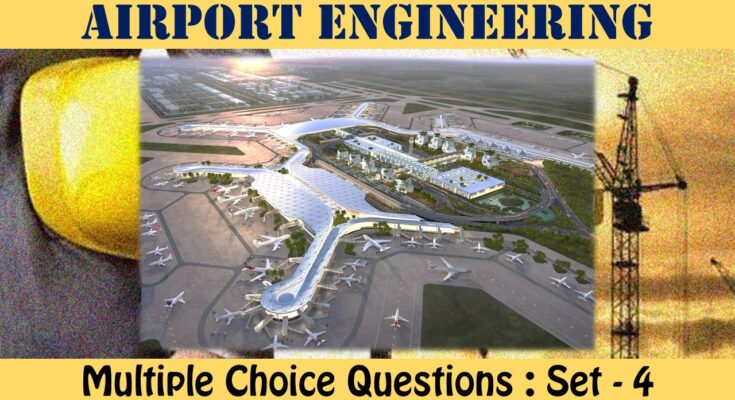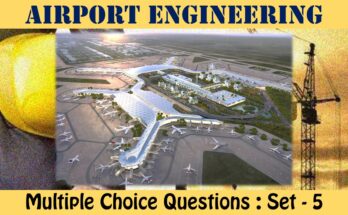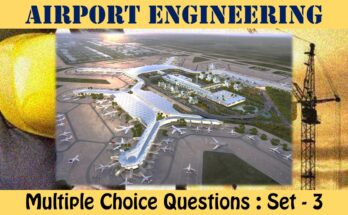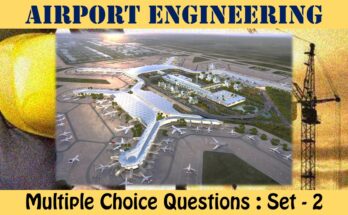MCQ Questions Civil Engineering Airport Engineering
The interviewer is almost as nervous as the candidate in most interviews. You might wonder if you look confident enough, if you will hire the right person, or if you are asking the right engineering interview questions. The last question is arguably the most crucial part to worry about when you’re interviewing candidates. Other topics on Civil Engineering Multiple Choice Questions can be accessed
MCQ Questions Civil Engineering Airport Engineering - Set - 4
Question 1:
Castor angle is defined as the angle
a) formed by the longitudinal axis of the aircraft and the direction of movement of the nose gear
b) between the direction of wind and the longitudinal axis of the runway
c) between the true speed of the aircraft and the crosswind component
d) between the horizontal and the fuselage axis
Correct Answer – (A)
Question 2 :
Which of the following factors are taken into account for estimating the runway length required for aircraft landing?
1. Normal maximum temperature
2. Airport elevation
3. Maximum landing weight
4. Effective runway gradient
Select the correct answer using the codes given below Codes:
a) 1, 2, 3 and 4
b) 1, 3 and 4
c) 2 and 3
d) 1, 2 and 4
Correct Answer – (D)
Question 3 :
Maximum gross take-off weight of an aircraft is
a) equal to the maximum structural landing weight
b) less than the maximum structural landing weight
c) more than the maximum structural landing weight
d) equal to the empty operating weight plus the payload
Correct Answer – (C)
Question 4 :
The length of clear zone for none instrument runway of a small aircraft is
a) 150 m
b) 300 m
c) 600 m
d) 750 m
Correct Answer – (B)
Question 5 :
Which of the following is used for servicing and repairs of the aircraft ?
a) Apron
b) Hanger
c) Terminal building
d) holding apron
Correct Answer – (B)
MCQ Questions Civil Engineering Airport Engineering
Question 6:
In an airport, if 4 groups of 5 gates each located well-separated are considered for traffic and the future to present traffic ratio is 3, then the total requirement of future gates will be
a) 32
b) 36
c) 44
d) 68
Correct Answer – (B)
Question 7:
Consider the following statements: Wind rose diagram is used for the purposes of
1. runway orientation
2. estimating the runway capacity
3. geometric design of holding apron Of these statements
a) 1 and 2 are correct
b) 2 and 3 are correct
c) 1 and 3 are correct
d) 1 alone is correct
Correct Answer – (D)
Question 8:
In approach areas of runways equipped with instrumental landing facilities any object within 4.5 km distance from runway end shall be considered as an obstruction if its height is more than
a) 20 m
b) 30 m
c) 45 m
d) 51 m
Correct Answer – (B)
Question 9:
The slope of the transitional surface for A, B and C type of runway shall be
a) 1:5
b) 1:7
c) 1:10
d) 1:12
Correct Answer – (B)
Question 10:
The main disadvantage of angle nose out parking configuration of aircraft is that the
a) aircraft rear loading door is far away from terminal building.
b) hot blast is directed towards the terminal building
c) overall apron area required is more
d) all the above
Correct Answer – (B)
- NCERT Solutions Class 12 Mathematics RD Sharma Sets : Exercise 1.1
- NCERT Solutions Class 12 Mathematics RD Sharma Sets : Exercise 1.2
- NCERT Solutions Class 12 Mathematics RD Sharma Sets : Exercise 1.3
- NCERT Solutions Class 12 Mathematics RD Sharma Sets : Exercise 1.4
- NCERT Solutions Class 12 Mathematics RD Sharma Trigonometric Functions : Exercise – 5.1
- NCERT Solutions Class 12 Mathematics RD Sharma Trigonometric Functions : Exercise – 5.2
- NCERT Solutions Class 12 Mathematics RD Sharma Trigonometric Functions : Exercise – 5.3
- NCERT Solutions Class 12 Mathematics RD Sharma Quadratic Equations : Exercise – 14.1
- NCERT Solutions Class 12 Mathematics RD Sharma Quadratic Equations : Exercise – 14.2
- NCERT Solutions Class 12 Mathematics RD Sharma Linear Inequations : Exercise – 15.1
- NCERT Solutions Class 12 Mathematics RD Sharma Linear Inequations : Exercise – 15.2
- NCERT Solutions Class 12 Mathematics RD Sharma Linear Inequations : Exercise – 15.3
- NCERT Solutions Class 12 Mathematics RD Sharma Linear Inequations : Exercise – 15.4
- NCERT Solutions Class 12 Mathematics RD Sharma Linear Inequations : Exercise – 15.5
- NCERT Solutions Class 12 Mathematics RD Sharma Linear Inequations : Exercise – 15.6
Multiple Choice Questions for Competitive Exams
- Multiple Choice Questions Class 12 Chemistry The Solid State
Set -1 Set -2 Set -3 Set -4 Set -5 - MCQ Questions Class 12 Solutions With Answers
Set -1 Set -2 Set -3 Set -4 Set -5 - MCQ Questions Class 12 Electrochemistry With Answers
Set -1 Set -2 Set -3 Set -4 Set -5 - MCQ Questions Class 12 Chemical Kinetics With Answers
Set -1 Set -2 Set -3 Set -4 Set -5 - MCQ Questions Class 12 Surface Chemistry With Answers
Set -1 Set -2 Set -3 Set -4 Set -5 - MCQ Questions Class 12 General Principles and Processes of Isolation of Elements With Answers
Set -1 Set -2 Set -3 Set -4 Set -5




